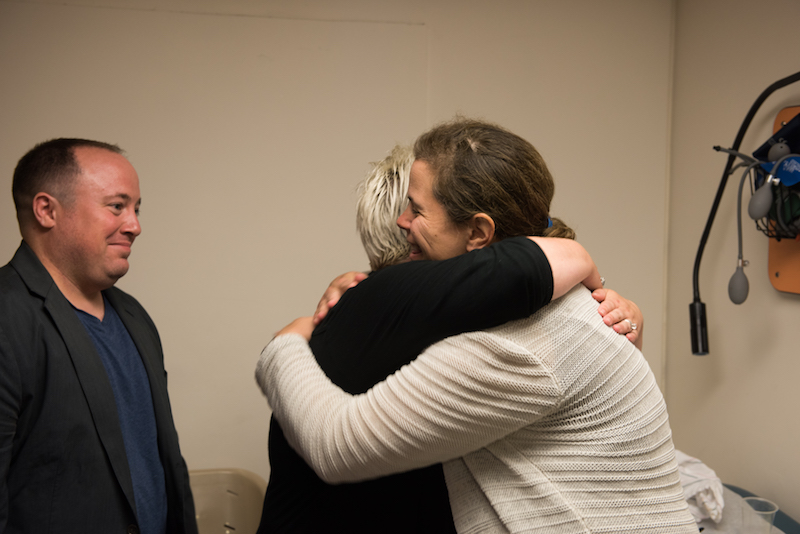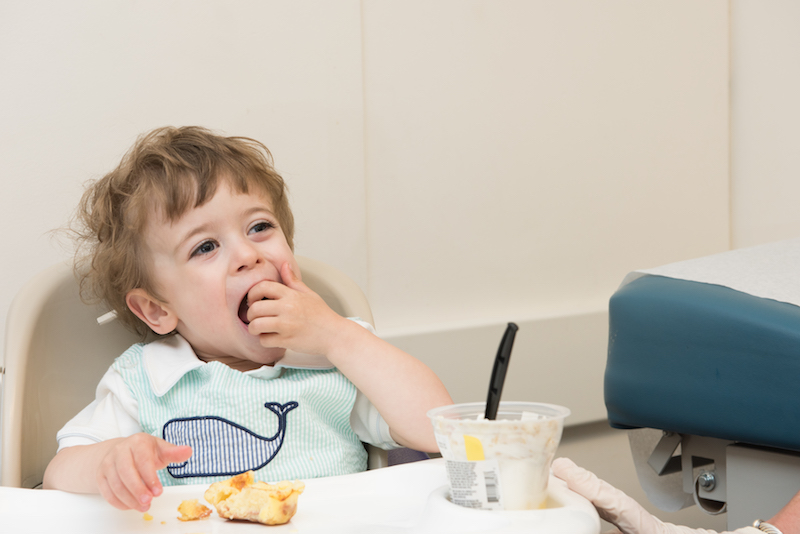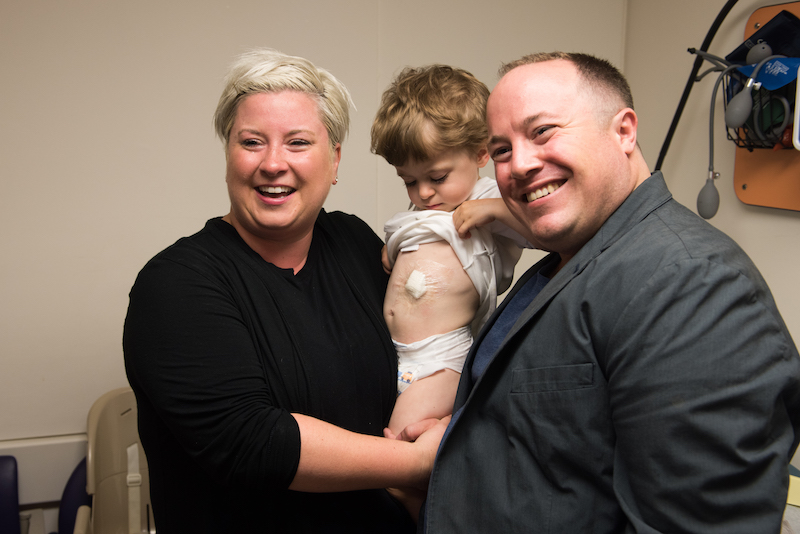Taking a leap of faith: Jack says goodbye to his G-tube

As they waited for their son Jack’s appointment, Marika and Josh Reuling had no indication that July 17, 2018, would be different from any other day. They chatted, glanced at the cartoons playing in the waiting room and handed Jack crayon after crayon as he happily colored a picture. It seemed like a just another routine check-up with Dr. Rachel Rosen, director of the Aerodigestive Center at Boston Children’s Hospital.
But once the Reulings were settled in an exam room and Jack had sampled a variety of foods as part of an evaluation with feeding specialist Kara Larson, Dr. Rosen had a surprise for them. “What do you think about taking out Jack’s G-tube today?” she asked.

‘Like the end of the world’
Almost exactly three years earlier, Jack had been delivered by emergency C-section after Marika developed HELLP syndrome, a serious hypertensive disorder of pregnancy that is life-threatening to a mother, and required the delivery of Jack at 28 weeks. Jack weighed just 1 pound, 14 ounces — tiny even for a preemie. After 110 days in his birth hospital’s neonatal intensive care unit (NICU), Jack went home with supplemental oxygen and a gastrostomy (G-tube).
The G-tube was meant to deliver nutrition directly to his stomach to ensure he received the calories necessary to grow. Yet it soon became clear that this wasn’t the best option for Jack. “He was having really bad reflux and vomiting about 20 times a day” says Marika.
Rosen, whom the family had met in the NICU, recommended switching to a gastro-jejunal (G-J) tube, which passes from the stomach into the small intestine. As new parents with no real knowledge of gastrointestinal problems, the Reulings were worried — a concern they recall now with a chuckle. “We thought it was the last resort,” Marika muses. “We felt as if we had already brought our baby home on life support — a feeding tube and oxygen — and now we were being told that Jack needed to bypass stomach feeding in order to eat. It seemed like the end of the world.”

A bumpy road
In fact, it was far from it. Although it required more maintenance than the G-tube, the G-J tube’s benefits were almost immediate, and Jack began to thrive. His ability to eat dramatically improved, and his parents were able to sleep through the night without worrying he would vomit.
Still, it wasn’t quite smooth sailing yet. In spring of 2017, Jack developed rickets — a deficiency disease that can sometimes result from enteral nutrition — which made it painful for him to walk and landed him in the hospital for more than two weeks. “We wouldn’t have even realized he had rickets if Dr. Rosen hadn’t just read a study about this connection,” says Marika. “She was totally on top of the research. I work at a university and appreciate the value of research, and it has been such a integral component of Jack’s care in the clinic.”
The next year held other ups and downs: After Jack pulled out his G-J tube while still in the hospital with rickets, Dr. Rosen proposed attempting going back to the G-tube. The family jumped at the chance to begin to wean to a G-tube. The multiple feeding challenges she recommended ultimately highlighted Jack’s slower gastrointestinal motility. To help improve his motility, Jack received injections of botulinum toxin to his stomach, which Jack’s father, Josh, describes as life-changing. “Jack could finally begin to eat orally and digest more normally.” But that same year, Jack also developed the flu, then sepsis, and as a result, hypothermia, and was in and out of the hospital.

Learning to love food
Even through such setbacks, Jack and his parents were focused on their goal: for him to be able enjoy food by mouth. Under Larson’s guidance, they would try novel approaches — placing Jack in a kiddie pool filled with foods like Jell-O and pasta so he could acclimate to smells and textures, even if he never took a taste. Larson also provided Jack with a suite of tools to support oral muscle development, including specialized chewing toys and vibrating spoons. Once he began to experiment with food, however, Jack didn’t hold back.
“We felt we needed to excite his taste buds with really vibrant flavors,” says Josh who, in addition to his job as an attorney, supports his family’s vineyard business in California, alongside Marika. “I grew up on a farm, and food has always been a vital part of my life. Marika and I love cooking at home and trying new recipes.” And so when Jack was able to begin eating orally, a whole new world opened up. Today, Jack favors stereotypically “grown-up” foods such as smoked salmon, lobster bisque and Sriracha chili sauce with vegetables over traditional “kid” foods like Goldfish crackers. “Snack time should be interesting when he starts preschool,” laughs his mom.

Ready for the future
Thanks to Jack’s hard work and adventurous palate, he hadn’t needed his G-tube for feedings since March 2018. But the Reulings were still shocked by Rosen’s suggestion to remove it. “We just assumed he would have it through another winter,” says Marika. While Dr. Rosen left the decision up to the family, they ultimately decided to take a leap of faith and remove the tube. “I’m a risk taker, and Josh is more risk averse,” Marika explains. “We view Dr. Rosen as a bit of a rebel, and we love that about her.”
For his part, Jack is a laidback kid who loves meeting people and rarely cries. When he’s not exploring the playground or reading with his grandmother, he’s making quirky pretend phone calls with his hand, dialing everyone from Barbra Streisand to Dr. Rosen. He’ll need to invest in an imaginary international data plan soon, however, as his parents are planning a celebratory trip to Europe with him. “Jack has been through so much,” says Marika. “We can’t wait for him to just enjoy life and all of its opportunities.”
Learn about the Aerodigestive Center.
Related Posts :
-

‘The reason I became a nurse’: Maeve’s memories of laryngeal cleft repair
Being a gastroenterology nurse is more than a profession for Maeve Lee. When she cares for patients with feeding tubes, ...
-

The best decision: Triplet Jayden is thriving after CDH repair
Jayden is barely a year old, but he’s already been through more ups and downs than some adults. Born ...
-

How transnasal endoscopy got Jamie back on the golf course
Jamie is like most 15-year-olds — he goes to school, hangs out with his friends, and still makes time to get ...
-

Advancing mother-child health globally: Grace Chan MD, MPH, PhD
First in an ongoing series profiling researchers at Boston Children's Hospital. Globally, five million children die annually before the age ...





